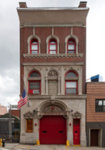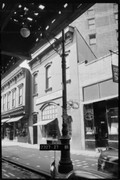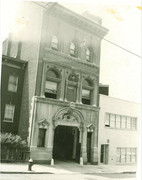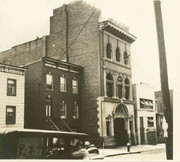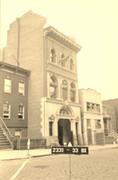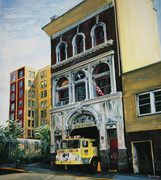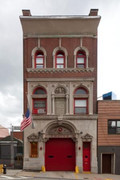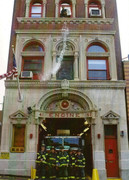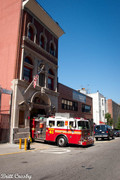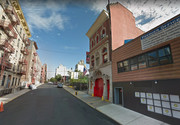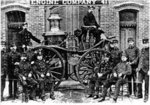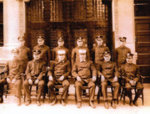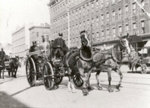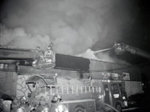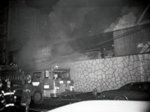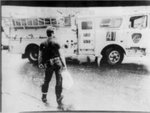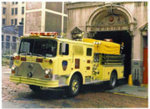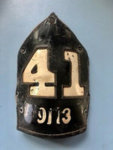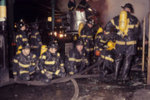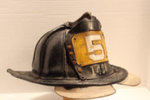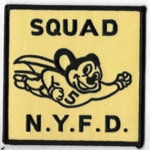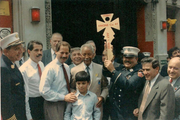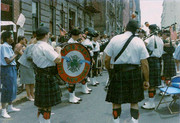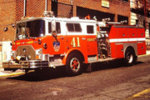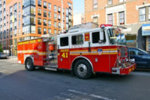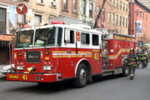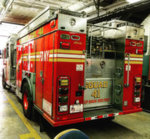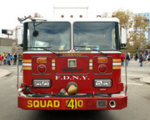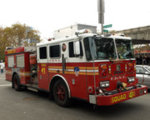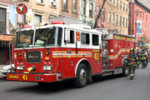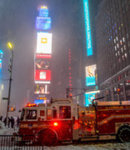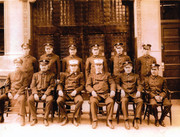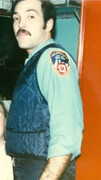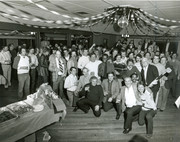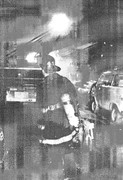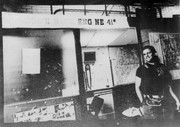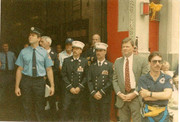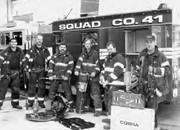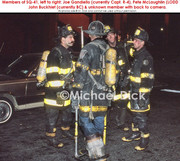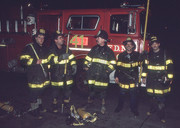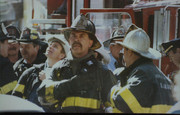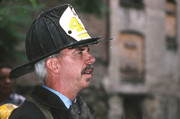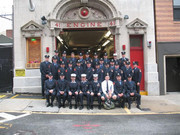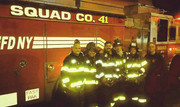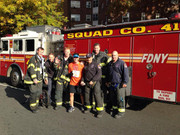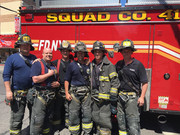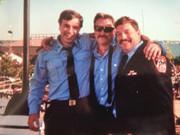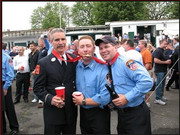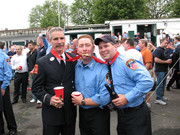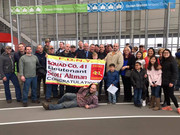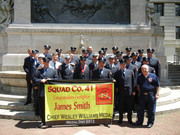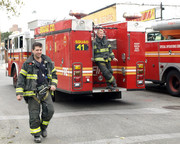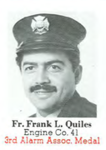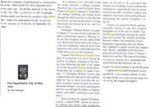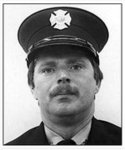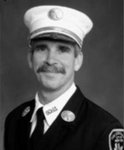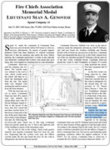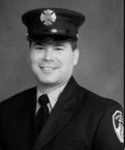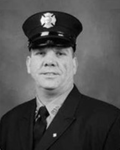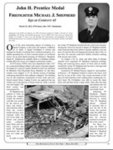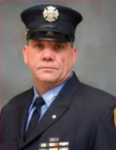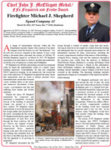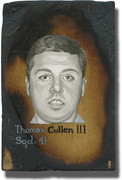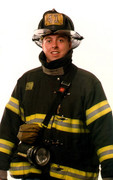Squad 41 (cont):
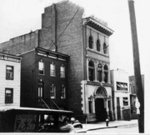
NYC Landmarks Preservation Commission - June 12, 2012
FIREHOUSE, ENGINE COMPANY 41 (now ENGINE COMPANY/SQUAD 41)
330 East 150th Street, Bronx
Built: 1902-03
Architect: Alexander Stevens
Landmark Site: Borough of the Bronx
On May 15, 2012, the Landmarks Preservation Commission held a public hearing on the proposed designation as a Landmark of the Firehouse, Engine Company 41 (now Engine Company/Squad 41) and the proposed designation of the related Landmark Site. The hearing had been duly advertised in accordance with the provisions of law. There were two speakers in favor of designation including the representatives of the Historic District Council and the Victorian Society in America. There were no speakers in opposition. The Fire Department sent correspondence indicating their support for designation.
SUMMARY:
The Firehouse for Engine Company 41, built 1902-03, was one of the first firehouses constructed in the Bronx after the Consolidation of the City of New York in 1898. Engine Company 41 was first established as a paid, professional company in 1874, just after the annexation of the Bronx to Manhattan. Their original building was located on Third Street in the populous Mott Haven section, in the building that had previously been used by the local volunteer company. With the tremendous population growth of the period and expansion of fire services after Consolidation, Engine Company 41 moved a few blocks north to South Melrose, to a new building that was one of the many new structures erected by the city to provide more government services to these new sections of the city. This building was designed by the Superintendent of Buildings for the Fire Department, Alexander Stevens, and is one of seven firehouses for which he is credited. All of Steven?s designs were in the Renaissance Revival style, a restrained classically-inspired style appropriate to the growing city and the popular ideas of the City Beautiful movement of the early 20th century. This building exhibits an imposing facade of ashlar limestone and brick, with round arches, keystones, moldings, colonnettes and a prominent eagle to reinforce its association with the American government.
Standing out from the industrial and residential buildings on this block, this firehouse represented the government and its protective services to the many new immigrants moving into this area at the turn of the century, and continued to do so through the difficult years of the 1960s and 70s. The engine company has expanded its services to become a Squad Company, and continues to use this building today.
DESCRIPTION AND ANALYSIS
Firefighting in New York
From the earliest colonial period, the government of New York took the possibility of fire very seriously. Under Dutch rule all men were expected to participate in firefighting activities. After the English took over, the Common Council organized a force of thirty volunteer firefighters in 1737. They operated two Newsham hand pumpers that had recently been imported from London. By 1798, the Fire Department of the City of New York (FDNY), under the supervision of a chief engineer and six subordinates was officially established by an act of the state legislature.
As the city grew, this force was augmented by new volunteer companies. In spite of growing numbers of firefighters and improvements in hoses and water supplies, fire was a significant threat in an increasingly densely built up city. Of particular significance was the ?Great Fire? of December 16-17, 1835, which caused more damage to property than any other event in New York City. The damages resulting from several major fires, which occurred between 1800 and 1850, led to the establishment of a building code, and an increase in the number of firemen from 600 in 1800 to more than 4,000 in 1865. Despite rapid growth, the department was often criticized for poor performance.2 Intense competition between companies began to hinder firefighting with frequent brawls and acts of sabotage, often at the scenes of fires. During the Civil War, when fire personnel became harder to retain, public support grew for the creation of a professional firefighting force, similar to that which had been established in other cities and to the professional police force that had been created in New York in 1845.
In May 1865, the New York State Legislature established the Metropolitan Fire District, comprising the cities of New York (south of 86th Street) and Brooklyn. The act abolished the volunteer system and created the Metropolitan Fire Department, a paid professional force under the jurisdiction of the state government. By the end of the year, the city?s 124 volunteer companies with more than 4,000 men had retired or disbanded, to be replaced by 33 engine companies and 12 ladder companies operated by a force of 500 men. Immediate improvements included the use of more steam engines, horses and a somewhat reliable telegraph system. A military model was adopted for the firefighters, which involved the use of specialization, discipline, and merit. By 1870, regular service was extended to the ?suburban districts? north of 86th Street and expanded still farther north after the annexation of parts of the Bronx in 1874.
New techniques and equipment, including taller ladders and stronger steam engines, increased the department?s efficiency, as did the establishment, in 1883, of a training academy for personnel. The growth of the city during this period placed severe demands on the fire department to provide services, and in response the department undertook an ambitious building
campaign. The area served by the FDNY nearly doubled after consolidation in 1898, when the departments in Brooklyn and numerous communities in Queens and Staten Island were
incorporated into the city. After the turn of the century, the Fire Department acquired more modern apparatus and motorized vehicles, reflecting the need for faster response to fires in taller buildings. Throughout the twentieth century, the department has endeavored to keep up with the evolving city and its firefighting needs.
FIREHOUSE DESIGN
By the early twentieth century, the firehouse as a building type had evolved from the wooden storage shed used during the seventeenth century to an imposing architectural expression
of civic character. As early as 1853, Marriott Field had argued in his City Architecture: Designs for Dwelling Houses, Stores, Hotels, etc. for symbolic architectural expression in municipal
buildings, including firehouses. The 1854 Fireman?s Hall, with its highly symbolic ornamentation reflected this approach, using flambeaux, hooks, ladders, and trumpets for its ornament.
Between 1880 and 1895, Napoleon LeBrun & Son served as the official architectural firm for the fire department, designing 42 firehouses in a massive effort to modernize the facilities and to accommodate the growing population of the city. Although the firm?s earliest designs were relatively simple, later buildings were more distinguished and more clearly identifiable as firehouses.
While the basic function and requirements of the firehouse were established early in its history, LeBrun is credited with standardizing the program, and introducing some minor, but important, innovations in the plan. Placing the horse stalls in the main part of the ground floor to reduce the time needed for hitching horses to the apparatus was one such innovation.
Firehouses were usually located on mid-block sites because these were less expensive than more prominent corner sites. Since the sites were narrow, firehouses tended to be three stories tall, with the apparatus on the ground story and rooms for the company, including dormitory, kitchen and captain?s office, above. After 1895, the department commissioned a number of well-known architects to design firehouses. Influenced by the classical revival which was highly popular throughout the country, New York firms such as Hoppin & Koen, Flagg & Chambers, and Horgan & Slatterly created facades with bold, classical style designs. After the turn of the 20th century, the Fire Department also used its own employees to design a series of buildings, all executed in a formal neo-classical style consistent with the ideas promoted by the City Beautiful movement. Government buildings were placed in neighborhoods throughout the city, with the intention of inspiring civic pride in the work of the government and the country as a whole. Buildings such as these fire houses are easily recognizable and announce themselves as distinct from private structures, using quality materials, workmanship and details to create buildings of lasting beauty and significance to their localities. Growth of The Bronx The area where Engine Company 41 is located, in the southwestern part of the Bronx, is called South Melrose. It was originally part of the extensive holdings purchased in 1670 by the Welsh-born Richard Morris (died 1672) and inherited in 1692 by his son Lewis Morris, later an Acting Governor of New York and Governor of New Jersey. Their large estate, known as ?Morrisania,? was part of Westchester County during the late eighteenth and most of the nineteenth centuries. In 1828, Jordan L. Mott, inventor of the coal-burning stove, bought a large tract of land in the southwestern part of Morrisania and established the Mott Haven Iron Works on the Harlem River at Third Avenue and 134th Street. The area around this business was developed with houses for Mott and his workers and became known as Mott Haven. The neighborhood of Melrose is located just to the north of Mott Haven. The development of this entire section was due to the expansion of the iron works and the advent of other industrial enterprises attracted by the Mott Haven Canal, which led from the Harlem River north to 138th Street. The New York & Harlem Railroad, incorporated in 1831, expanded over the Harlem River in 1840, bringing goods and people to the community.
Soon Morris began to develop the rest of his property and, in 1850, worked with surveyor Andrew Findley to lay out the villages of Woodstock, Melrose, and Melrose East and Melrose
South. By 1868 there were 488 citizens living in Melrose South, primarily Germans who came from the crowded area of Kleinedeutschland on Manhattan?s Lower East Side. Beginning in the 1860s, streets were laid out and land speculation began in earnest, aided by the railroads and streetcars that began to serve the area.In 1874, the townships of Morrisania, West Farms and Kingsbridge split from Westchester County and became the 23rd and 24th wards of the City of New York. This area of the Bronx became known as the Annexed District. Beginning in the early 1880s, booster organizations such as the North Side Association advocated for infrastructure improvements such as street paving and new sewers. The elevated railroad opened a line along Third Avenue in1888, opening the area to the process of urbanization, which increased substantially with the arrival of the subway in 1904.By 1897, just a decade after the el began operation, the once vacant blocks east of Third Avenue were almost completely built over with solid brick buildings. This area held a mixture of building types: single-family town houses built in the late 1880s; multi-story apartment houses, built with increasing frequency in the 1890s; and various industrial and manufacturing establishments along the neighborhood?s southern fringe. Encouraged by all this growth, grocery stores, restaurants, vegetable and fruit markets, tailors and hardware stores were established. By the turn of the 20th century, the commercial heart of Melrose was centered on the intersection of East 149th Street, Melrose, Willis and Third Avenues, known as the Hub. It is the oldest major shopping district in the Bronx, patronized by residents of all areas of the Bronx, and its offerings grew to include department stores, boutiques, movie palaces and vaudeville theaters.
The population of the Bronx grew rapidly. In 1890, there were 89,000 people living in the area of the Bronx known as the North Side; ten years later it had more than doubled to over
200,000. By 1915, this number had increased threefold, to 616,000. As the population and number of new buildings increased, protection from the ever present danger of fire became
increasingly important. The firehouse for Engine Company/Squad 41 was built on East 150th Street as part of the effort to protect the expanding numbers of houses and tenements in this area of South Melrose.
FIREHOUSE ENGINE COMPANY 41
Engine Company 41 was one of the first organized as a professional company in the Bronx, just after its annexation in 1874. Its organizing date is January 1, 1874 and it was located at 501 (later renumbered as 2801) North Third Street, the former home of the volunteer Jackson Engine Company 4. This building was located within the populous neighborhood of Mott Haven. After Consolidation of the City of New York in 1898, the fire department set about creating and upgrading their facilities in the large areas now under their control. Substantial bond issues were released to enable the department to purchase many new lots for this construction. The land for a new house for Engine Company/Squad 41 was purchased as part of such a bond issue in 1902. It was located somewhat north of the original house, on East 150th Street, in the expanding Melrose section. Although many of the new buildings from this period were designed by contract with different architectural firms, the design for this house was created by the Superintendent of Buildings of the Fire Department, in order to save time and money. A New Building permit was issued in June, 1902. Construction began in February, 1903 and was completed by the following December. Construction work was performed by the firm of Fanning & Reilly and the building cost $32,800.00.
Engine Company 41 has remained at this address since that time, although various organizational changes have occurred. The company was extremely busy during the period of the 1960s and 70s when fires were started in record numbers in the South Bronx. They received a second piece of equipment to help with this heavy load and the second section was designated as Engine Company 41-2, which continued (later as Squad Company 5) until it was disbanded in 1976. In an effort to economize, Engine Company 41 was disbanded in May 1989, but a rise in fire fatalities in the area and protests by residents resulted in the company being reorganized and put back into service on July 1, 1990. In 1990, the Company was designated Engine Company/Squad 41, an ?enhanced engine company.? This appellation indicated increased responsibility to respond to more and higher levels of alarms and to perform squad company work outside of their regular area. Squads have more highly trained and differentiated personnel and can also respond to Haz-Mat situations.
Engine/Squad 41 is one of two squad companies now working in the Bronx. This company responded to the World Trade Center on September 11, 2001 and consequently lost six men on that day.
ALEXANDER STEVENS
Alexander Stevens graduated as a civil engineer from Columbia College in 1887. A resident of New York City, he was first employed by the Pennsylvania Railroad Company. In 1897 he was appointed as Superintendent of Buildings for the Fire Department. In this capacity he probably oversaw the renovation of existing firehouses, assembled the specifications for the commissions that the Fire Department awarded independent architects, and supervised the construction of new buildings for the department. In the Superintendent?s Report of the Fire Department Annual Report for 1902, Stevens remarks that his department is capable of designing new firehouses as well as outside architects and thus can save funds for the department. In his designs, Stevens follows the established pattern of three-story, three-bay wide firehouses with classical ornament established by Napoleon LeBrun and others who had designed many New York firehouses. Stevens is credited with designing seven firehouses in the city between 1903 and 1906 while he served in this position. The building for Hook & Ladder Company 8 stands in the Tribeca West Historic District (10 North Moore Street, 1903). Engine Company 23, 215 West 58th Street is a designated New York City Landmark. All of his designs use similar neo-Renaissance motifs such as a dominant central bay with round-arched openings embellished with colonnettes, moldings and keystones.
DESCRIPTION
Three story, three bay firehouse faced in ashlar limestone on 1st story and most of 2nd story with brick above. A stepped, granite base sits below the limestone.
Historic: Symmetrical arrangement with large central, round-arched opening for fire truck flanked by pedestrian opening and window, both with triangular pediments; ?Engine 41? over
opening; tympanum filled with shield and swags, topped by elaborate keystone and anthemion; stone frieze; colonnettes, eagle, friezes and medallions ornament 2nd story windows; stone
commemorative plaque in center bay of 2nd story; third story has three windows with continuous stone sill supported by brackets, round-arched windows with stone colonnettes, moldings and elongated, ornamented keystones.
Alterations: Pedestrian and vehicular doors replaced; 1st story window replaced by wood with wood enframement; original iron cornice covered by sheet metal; spotlights, flagpole added.
Site: Both side facades are plain, painted brick. The firehouse sits at the lot line on East 150th Street and fills its entire lot.
FINDINGS AND DESIGNATION
On the basis of a careful consideration of the history, the architecture, and other features of this building, the Landmarks Preservation Commission finds that Firehouse, Engine Company/Squad 41 has a special character and a special historical and aesthetic interest and allure as part of the development, heritage, and cultural characteristics of New York City. The Commission further finds that this firehouse for Engine Company/Squad 41, constructed 1902-03, was one of the first firehouses constructed in the Bronx after the Consolidation of the City of New York in 1898; that this company was one of the first organized as a professional company immediately following the annexation of the Bronx in 1874, in their first home located in Mott Haven; that after Consolidation, as the Bronx was growing rapidly, this was one of the numerous new buildings the Fire Department constructed to serve the areas newly under its jurisdiction, such as this area slightly farther north, called South Melrose; that the building for Engine Company/Squad 41 was one of seven firehouses designed by the Superintendent of Buildings for the Fire Department, Alexander Stevens; that Stephens, who oversaw the construction of numerous firehouses designed by outside architectural firms, based his designs on other firehouses being built at the time; that this building has a three-story, three-bay wide, symmetrical facade with an ashlar limestone base and brick above; that its strong, round-arched openings with moldings and keystones, its classical ornamental vocabulary such as engaged colonnettes and modillioned cornice, as well as its solid construction are typical of government buildings built during the heyday of the City Beautiful movement at the turn of the 20th century; that this building has remained in use for its original purpose and continues to serve as the home of Engine Company/Squad 41, and serves as a reminder of the period of growth and promise in the years after the consolidation of New York City.
